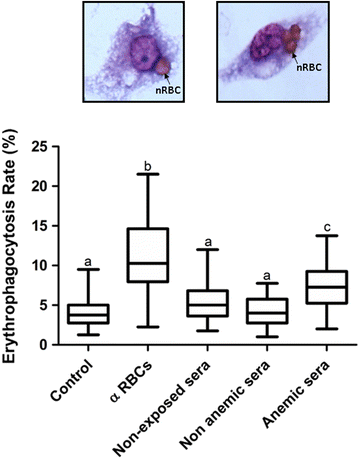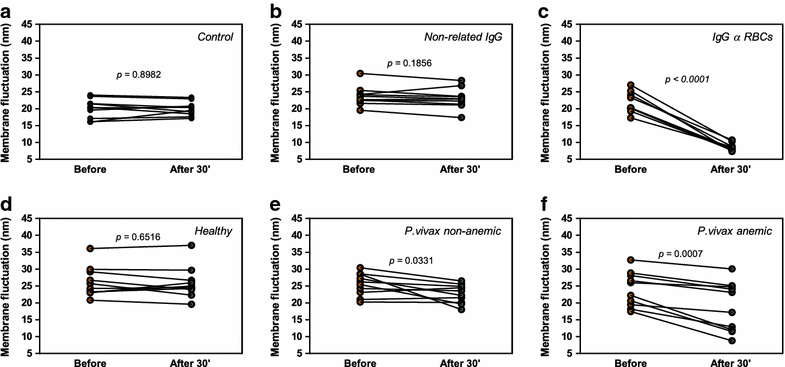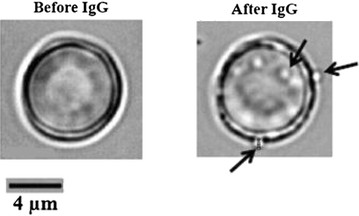Anti-erythrocyte antibodies may contribute to anaemia in Plasmodium vivax malaria by decreasing red blood cell deformability and increasing erythrophagocytosis
- PMID: 27488382
- PMCID: PMC4973037
- DOI: 10.1186/s12936-016-1449-5
Anti-erythrocyte antibodies may contribute to anaemia in Plasmodium vivax malaria by decreasing red blood cell deformability and increasing erythrophagocytosis
Abstract
Background: Plasmodium vivax accounts for the majority of human malaria infections outside Africa and is being increasingly associated in fatal outcomes with anaemia as one of the major complications. One of the causes of malarial anaemia is the augmented removal of circulating non-infected red blood cells (nRBCs), an issue not yet fully understood. High levels of auto-antibodies against RBCs have been associated with severe anaemia and reduced survival of nRBCs in patients with falciparum malaria. Since there are no substantial data about the role of those antibodies in vivax malaria, this study was designed to determine whether or not auto-antibodies against erythrocytes are involved in nRBC clearance. Moreover, the possible immune mechanisms elicited by them that may be associated to induce anaemia in P. vivax infection was investigated.
Methods: Concentrations of total IgG were determined by sandwich ELISA in sera from clinically well-defined groups of P. vivax-infected patients with or without anaemia and in healthy controls never exposed to malaria, whereas the levels of specific IgG to nRBCs were determined by cell-ELISA. Erythrophagocytosis assay was used to investigate the ability of IgGs purified from each studied pooled sera in enhancing nRBC in vitro clearance by THP-1 macrophages. Defocusing microscopy was employed to measure the biomechanical modifications of individual nRBCs opsonized by IgGs purified from each group.
Results: Anaemic patients had higher levels of total and specific anti-RBC antibodies in comparison to the non-anaemic ones. Opsonization with purified IgG from anaemic patients significantly enhanced RBCs in vitro phagocytosis by THP-1 macrophages. Auto-antibodies purified from anaemic patients decreased the nRBC dynamic membrane fluctuations suggesting a possible participation of such antibodies in the perturbation of erythrocyte flexibility and morphology integrity maintenance.
Conclusions: These findings revealed that vivax-infected patients with anaemia have increased levels of IgG auto-antibodies against nRBCs and that their deposition on the surface of non-infected erythrocytes decreases their deformability, which, in turn, may enhance nRBC clearance by phagocytes, contributing to the anaemic outcome. These data provide insights into the immune mechanisms associated with vivax malaria anaemia and may be important to the development of new therapy and vaccine strategies.
Keywords: Anaemia; Auto-antibodies; Defocusing microscopy; Erythrophagocytosis; Non-infected RBC; Plasmodium vivax.
Figures




Similar articles
-
Effects of IgG and IgM autoantibodies on non-infected erythrocytes is related to ABO blood group in Plasmodium vivax malaria and is associated with anemia.Microbes Infect. 2020 Sep;22(8):379-383. doi: 10.1016/j.micinf.2020.02.003. Epub 2020 Feb 22. Microbes Infect. 2020. PMID: 32097712
-
Anti-band 3 and anti-spectrin antibodies are increased in Plasmodium vivax infection and are associated with anemia.Sci Rep. 2018 Jun 8;8(1):8762. doi: 10.1038/s41598-018-27109-6. Sci Rep. 2018. PMID: 29884876 Free PMC article.
-
Loss of complement regulatory proteins on red blood cells in mild malarial anaemia and in Plasmodium falciparum induced blood-stage infection.Malar J. 2019 Sep 18;18(1):312. doi: 10.1186/s12936-019-2962-0. Malar J. 2019. PMID: 31533836 Free PMC article.
-
The anaemia of Plasmodium vivax malaria.Malar J. 2012 Apr 27;11:135. doi: 10.1186/1475-2875-11-135. Malar J. 2012. PMID: 22540175 Free PMC article. Review.
-
Mechanisms of band 3 oxidation and clustering in the phagocytosis of Plasmodium falciparum-infected erythrocytes.Redox Rep. 2003;8(5):300-3. doi: 10.1179/135100003225002943. Redox Rep. 2003. PMID: 14962370 Review.
Cited by
-
Plasmodium DNA-mediated TLR9 activation of T-bet+ B cells contributes to autoimmune anaemia during malaria.Nat Commun. 2017 Nov 3;8(1):1282. doi: 10.1038/s41467-017-01476-6. Nat Commun. 2017. PMID: 29101363 Free PMC article.
-
Humoral immunity prevents clinical malaria during Plasmodium relapses without eliminating gametocytes.PLoS Pathog. 2019 Sep 19;15(9):e1007974. doi: 10.1371/journal.ppat.1007974. eCollection 2019 Sep. PLoS Pathog. 2019. PMID: 31536608 Free PMC article.
-
Rosettes integrity protects Plasmodium vivax of being phagocytized.Sci Rep. 2020 Oct 7;10(1):16706. doi: 10.1038/s41598-020-73713-w. Sci Rep. 2020. PMID: 33028898 Free PMC article.
-
Autoantibody levels are associated with acute kidney injury, anemia and post-discharge morbidity and mortality in Ugandan children with severe malaria.Sci Rep. 2019 Oct 17;9(1):14940. doi: 10.1038/s41598-019-51426-z. Sci Rep. 2019. PMID: 31624288 Free PMC article.
-
Divergent Roles of Antiself Antibodies during Infection.Trends Immunol. 2018 Jul;39(7):515-522. doi: 10.1016/j.it.2018.04.003. Epub 2018 Apr 30. Trends Immunol. 2018. PMID: 29724608 Free PMC article. Review.
References
Publication types
MeSH terms
Substances
LinkOut - more resources
Full Text Sources
Other Literature Sources
Medical

